 The Lucy Stone
walk-a-thon Tour
The Lucy Stone
walk-a-thon TourFor Women's Equality Day, August 25, 1979, four women from the Oberlin College community, Marlene Merrill, Gertrude Jacob, Sue Copeland Meek, and Becky Eastman, created this tour of selected sites relevant to women's history. The tour started at the Carnegie Library building, then the home of the Oberlin Public Library. It also included a rest stop at the Community Center, demolished in January 1997 when the Oberlin Community Services Council relocated farther south on Main Street. The maps have been up-dated to include the present locations or names of these buildings.
The four "loops" of this tour make for a rigorous walk, while providing a healthy engagement in Oberlin's very special relationship to the historic achievements of women. The Electronic Oberlin Group thanks Marlene Merrill for making the tour available.
For all maps, the following directive
applies: 
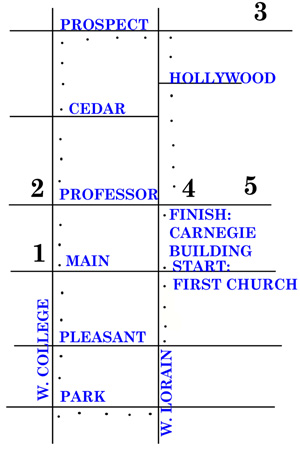
1. Site of Oberlin Hall, early College classroom building. Antoinette Brown Blackwell, first woman ordained as a Protestant minister in the U.S. studied for the ministry in the Theology Department here but was discouraged because of her sex and received no recognition at commencement. Not until 1908 at age 83 was she finally acknowledged through the bestowal of an honorary degree of Doctor of Divinity from the College.
2. Site of calisthenics rooms adjoining the women students' boarding house, Second Ladies' Hall. In 1885 Dr. Delphine Hanna was invited to become Oberlin College's first instructor in Physical Education and used this as her gym. The first faculty in Physical Education in the men's department were her students.
3. 192 N. Prospect. Home of Clara Cotton Bowie, one of a small number of black women with PhD's in the 1940's. This nationally-known psychologist graduated from Oberlin College and returned here to live in 1962 to a house she designed primarily herself.
4. Site of Alice Welch Cowles' home. She was Principal of the Ladies' Department 1836-40 and strongly opposed the entrance of women into the regular BA program in 1837.
5. (North of Severance Hall). Site of Zeruiah Porter Weed's home. First woman graduate of Oberlin College (1838). Certificate from the Ladies' Department.
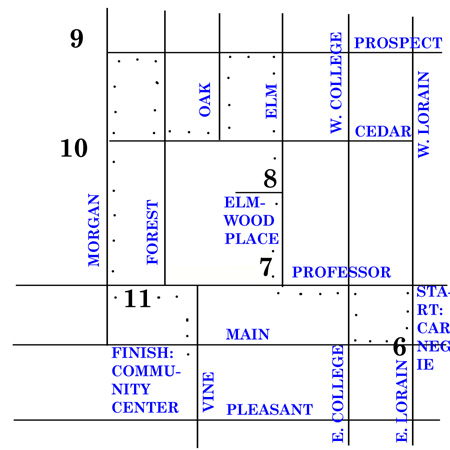
6. Mary Jane Patterson, the daughter of a grocer whose store was on the site of the present Allen Art Museum, became the first black woman to receive a college degree in the U.S. when she graduated from Oberlin College in 1862. She later became principal of the first preparatory high school for "colored youth" in Washington D.C.
7. Behind the 68 S. Professor St. home lies a building used as a studio for many years by Julia Severance, native Oberlinian and designer of the still official Oberlin College Seal.
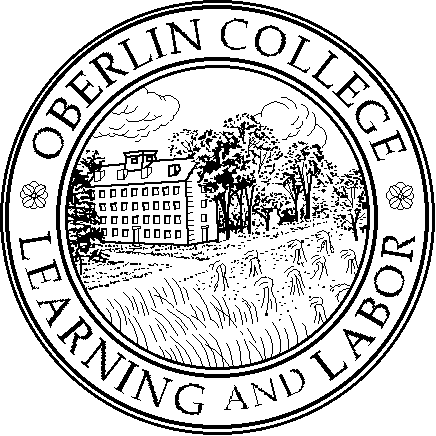
8. 137 Elm Street. Home of Elizabeth Storrs Mead and Hiram Mead. From 1869 to 1881 Hiram Mead was Professor of Sacred Rhetorical Pastoral Theology. Elizabeth Storrs Mead progressed from instructor of English at the College to become President of Mt. Holyoke College in 1890. During her tenure there its enrollment nearly tripled, the campus was virtually rebuilt and it moved from seminary to full collegiate status.
9. Ladies' Grove. The College rules of 1859 read: "Young ladies who do not reside with their parents are not allowed to walk in the fields or woods excepting the grove assigned for this purpose."
10. Somewhere in the woods near the College, Lucy Stone, Antoinette Brown Blackwell, and other women students convened their own debating society in 1846 because they were not permitted as women to take part in public debating.
11. Down the path from General Shurtleff's statue is a boulder commemorating the efforts of Mrs. A.A. Johnson who laid much of the groundwork for the establishment of a public park along Plum Creek.
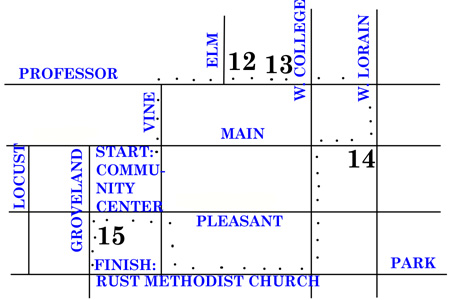
12. Between Baldwin House and Elm Street was the location of the home of Caroline Rudd Allen and her husband George, founder of Oberlin's courses in music and the Musical Union. She was one of the group of four women to enter the BA program in 1837.
13. Baldwin House. Home of the first woman to be granted faculty status at Oberlin College (1878) as "Instructor of History". Adelia Field Johnston later became a Dean and Professor of Medieval History.
14. The Co-Educational Gateway monument was erected in 1937, 100 years after the first four women were allowed to enroll in the College's BA program rather than in the Ladies' Department. The difference was the study of the Classical languages Latin and Greek which had been considered "too vigorous" for the minds of young women. The first four women were Mary Hosford, Mary Kellogg, Elizabeth Pratt, and Caroline Rudd.
15. 102 Groveland. Home of Natalie Hinderas, well-known black pianist. Native of Oberlin, she graduated from the Conservatory and was named a Trustee of the College in 1974.
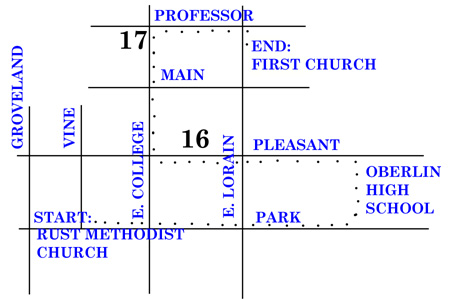
16. In the empty lot near Hall Auditorium is the site of Frances Willard's childhood home. A well-known educator and suffragist, she was also the founder of the Women's Christian Temperance Union (W.C.T.U.).
17. Location of the first boarding hall for women at an American college, First Ladies' Hall, 1836.
(Prepared for the Alumni of Oberlin College, Assembled August 22, 1860, published in Oberlin, Ohio: R. Butler, Printer, News Office, 1871) 40-43.
Map and notes are the
efforts of Marlene Merrill, Gertrude Jacob, Sue Copeland Meek, and
Becky Eastman. Updated maps were done using Adobe Photoshop.